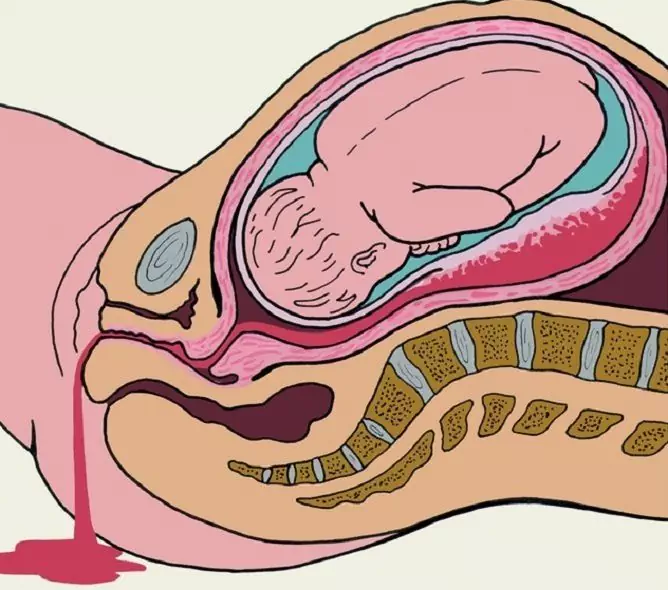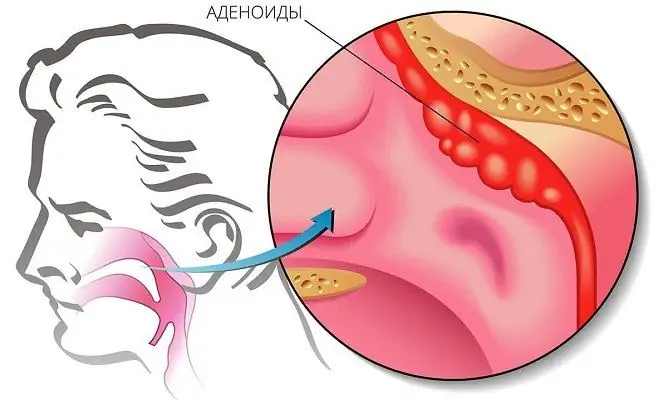- Author Rachel Wainwright [email protected].
- Public 2023-12-15 07:39.
- Last modified 2025-11-02 20:14.
Laryngotracheitis
The content of the article:
- Laryngotracheitis reasons
- Forms
- Laryngotracheitis symptoms
- Diagnostics
- Laryngotracheitis treatment
- Possible complications and consequences
- Forecast
- Prevention
Laryngotracheitis is a lesion of the mucous membrane of the trachea (tracheitis) and larynx (laryngitis) of an infectious and inflammatory nature. The process is localized mainly in the laryngeal lining and is manifested by shortness of breath, painful cough and inspiratory dyspnea.

Source: gorlonos.com
The main function of the trachea is to conduct air between the bronchi and the larynx. With the inflammatory process in the airways, the proliferation of the epithelium of the mucous membrane occurs, the hyperproduction of the secretion of mucoviscellular cells, which leads to edema and narrowing of the tracheal lumen. The process of narrowing the air duct and impaired air circulation is accompanied by respiratory disorders: shortness of breath, cough, stridor breathing. The functions of the trachea include the function of a resonator for the vocal cords. With the involvement of the vocal cords in the inflammatory process, the irritated peri-ligamentous tissue begins to press on the larynx region, wheezing and hoarseness appear.
The disease develops as a result of the transition of the pathological process from the overlying respiratory organs, starting, as a rule, with a viral lesion. In children, it can manifest itself with signs of false croup - edema with compression of the airways and suffocation (stenosing laryngotracheitis).
The rise in the incidence of laryngotracheitis occurs in the cold season (autumn, winter), periods of acute respiratory viral infections.
Laryngotracheitis reasons
Laryngotracheitis is caused by damage to the mucous membrane of the larynx and upper trachea, which leads to the development of inflammation. The inflammation has an infectious etiology. It can be provoked by both a viral infection (ARVI, herpes, adenovirus infection, influenza, parainfluenza type 1, 2 and 3 and RSV, measles, rubella, chickenpox, scarlet fever), and bacterial (pneumococci, staphylococci, streptococci, mycobacterium tuberculosis). Inhalation of dust or harsh chemicals can also damage the mucous membrane of the upper respiratory tract.
Risk factors for the development of laryngotracheitis include:
- allergic diseases;
- airway hyperresponsiveness;
- decrease in the body's immunological reactivity;
- somatic pathology (chronic gastritis, hepatitis, tuberculosis, diabetes mellitus, liver cirrhosis, rheumatism, glomerulonephritis, pyelonephritis, ischemic heart disease);
- pathology of the development of the respiratory tract, violation of physiologically correct breathing through the nose (curvature of the nasal septum, choanal atresia, sinusitis);
- congestion in the lungs (bronchial asthma, pulmonary emphysema, pneumosclerosis);
- smoking;
- a sharp decrease in the temperature of the inhaled air;
- harmful conditions of professional activity (dustiness, air pollution, chemicals, systematic voice loads).
Forms
According to the etiological factor, laryngotracheitis is:
- viral;
- bacterial;
- mixed;
- unexplained etiology.
In the course of the disease, two forms of laryngotracheitis are distinguished:
- acute - develops against the background of an infectious pathology of the respiratory tract.
- chronic - acute pathology leads to it with inadequate treatment or in its absence; protracted inflammatory process with alternating periods of remission and exacerbations.
Acute laryngotracheitis, in turn, has the following forms:
- catarrhal;
- hydropic;
- phlegmonous (infiltrative-purulent), which also has infiltrative and abscessing variants.
Chronic laryngotracheitis is of the following types:
- catarrhal - slight redness and some swelling of the mucous membrane in the vocal cords and trachea;
- atrophic - a change in the structure of the mucous membrane, its thinning, desiccation;
- hyperplastic - thickening and proliferation of mucosal tissue in the trachea and larynx.
Laryngotracheitis symptoms
The clinical picture of laryngotracheitis depends on the nature of the course of the disease. Acute laryngotracheitis causes the following symptoms:
- headache;
- rhinorrhea;
- increased body temperature;
- perspiration, severe sore throat, discomfort when swallowing;
- muscle pain;
- enlargement and soreness of the cervical lymph nodes;
- paroxysmal barking, dry cough, worse in the evening;
- chest pain during coughing fits;
- discharge of viscous and thick sputum;
- hoarseness, hoarseness of the voice;
- hard breathing and dry wheezing in the projection of the trachea;
- increasing symptoms of laryngeal stenosis;
- inspiratory dyspnea.

In the chronic course of laryngotracheitis, the symptoms are as follows:
- rapid fatigue of the vocal apparatus;
- permanent or temporary voice disturbances (dysphonia) of varying severity, hoarseness, changes in voice timbre;
- paroxysmal cough, more often morning;
- discomfort in the throat;
- with a hyperplastic form of the disease - shortness of breath, inspiratory dyspnea, respiratory failure may develop.
Diagnostics
Comprehensive diagnostics of laryngotracheitis should be carried out on the basis of the clinical picture, anamnesis data (special attention is paid to past diseases of the respiratory tract and digestive organs), examination results, bacteriological and instrumental studies.
When examining the larynx, it is performed, first of all, its visual examination and palpation. During the examination, the symmetry, swelling of the larynx is assessed. In acute laryngotracheitis, hyperemia and edema of the mucous membrane of the larynx in the form of hyperemic ridges under the free edges of the vocal folds is revealed.
The examination of the larynx can be done with direct or indirect laryngoscopy. With indirect laryngoscopy, a laryngeal mirror is used, with direct laryngoscopy, the examination is carried out directly. Another method of examining the larynx is microlaryngoscopy. This method involves performing an indirect laryngoscopy using endoscopic techniques, microscopes and binocular loupes.
Using a laryngeal speculum, an indirect tracheoscopy can also be performed to assess the condition of the mucous membrane of the upper trachea. Diagnostic signs of involvement in the inflammatory process of the trachea are hyperemia, punctate hemorrhages, edema.
Palpation allows you to determine the mobility of the larynx, the condition of its cartilage, the presence of tissue edema, pain and crepitus. By shifting the larynx to the sides, a crunch symptom is determined: a crunch in the larynx is normal, its absence indicates a possible disease of the larynx.
During auscultation of the lungs (that is, listening with a phonendoscope), breathing disorders are detected: wheezing, stridor.
Laboratory tests are carried out: a general blood test, which allows to identify an inflammatory process (leukocytosis, an increase in the erythrocyte sedimentation rate), a general urinalysis, a biochemical blood test.
To determine the causative agent of laryngotracheitis, bacteriological, bacterioscopic and serological methods are used, including polymerase chain reaction to isolate the DNA of the pathogen. As a material for research, sputum or scraping from the surface of the palatine arches, separated from the larynx and trachea, is used. When the pathogen is isolated, its sensitivity to antibacterial drugs is also determined, which makes it possible to prescribe the most effective pharmacological therapy.
Additional diagnostic methods include:
- X-ray of the larynx - performed in frontal and lateral projections;
- X-ray of the lungs - allows you to clarify the level of obstruction, is used to diagnose broncho-pulmonary complications of laryngotracheitis;
- endofibrolaryngotracheoscopy;
- study of the function of external respiration.
In complex diagnostic cases, additional methods are used:
- esophagoscopy - used to exclude the pathology of the esophagus;
- fibrolaryngoscopy - a method for diagnosing the larynx and vocal cords;
- tomography of the mediastinum;
- computed tomography of the larynx and trachea - performed if necessary, differential diagnosis with laryngeal cancer.
If a tuberculous etiology of laryngotracheitis is detected, the patient is examined by an otolaryngologist together with a phthisiatrician. If you suspect an allergic nature of the disease, an allergist consultation with an allergy test is required. In cases where laryngotracheitis is a manifestation of syphilis - consultation with a venereologist. For patients with severe phlegmonous forms of laryngitis, consultation with a surgeon is indicated. If hypertrophic changes are detected during laryngotracheoscopy, an oncologist should be consulted.
Laryngotracheitis must be differentiated from laryngeal edema, diphtheria, epiglottis abscess, pneumonia, severe laryngitis, chondroperichonritis, laryngeal papillomatosis, bronchial asthma, and malignant tumors.
Laryngotracheitis treatment
Treatment of laryngotracheitis should be comprehensive and aimed at eliminating the etiology of the disease. Its tasks:
- elimination of the inflammatory process in the larynx;
- restoration of voice and respiratory functions;
- preventing the transition to a chronic form.
Pharmacological therapy:
- therapy of concomitant pathology of the upper and lower respiratory tract, immune status, gastroesophageal reflux;
- systemic antibacterial therapy with broad-spectrum drugs in the case of bacterial etiology of the disease or the addition of bacterial microflora to a viral infection;
- mucolytics and secretolytics in the presence of viscous sputum or dry mucous membrane.
In the treatment of chronic laryngotracheitis, stimulating and absorbing agents, antihistamines and drugs that improve microcirculation are used.

Source: xcook.info
Physiotherapy procedures are effective:
- inhalation of humidified oxygen;
- inhalation with solutions of antispasmodic and antihistamines, proteolytic enzymes;
- electrophoresis in the larynx region;
- UHF;
- inductothermy;
- phonophoresis;
- therapeutic laser;
- phonopedics in hypotonic disorders of the voice function;
- massage.
In case of complications of laryngotracheitis in the form of abscessing and infiltrative forms, severe inspiratory dyspnea, signs of hypoxia, immediate hospitalization, intravenous detoxification therapy, parenteral nutrition, intravenous antibiotic therapy, correction of acid-base balance disorders are indicated.
If the narrowing of the larynx with stenosing laryngotracheitis reaches III - IV degree (the severity of obstruction is 70-100%), intubation or tracheostomy is performed for health reasons.
Possible complications and consequences
Possible complications of acute laryngotracheitis:
- edematous laryngitis;
- tracheobronchitis;
- epiglottitis;
- bronchiolitis;
- pneumonia;
- epiglottis abscess;
- the threat of developing stenosis of the larynx and trachea;
- false croup;
- malignant transformation of cells of the larynx mucosa in chronic hyperplastic form.
Forecast
With an uncomplicated course of acute laryngotracheitis, the prognosis is favorable, full therapy allows you to completely get rid of the symptoms of the disease. Chronization of the inflammatory process and the appearance of complications worsen the prognosis.
Prevention
The main measures for the prevention of laryngotracheitis:
- increasing the protective properties of the body;
- timely treatment of acute laryngitis, gastroesophageal reflux disease, infectious diseases of the upper and lower respiratory tract;
- treatment of allergic diseases;
- to give up smoking;
- compliance with the voice mode.
YouTube video related to the article:

Anna Aksenova Medical journalist About the author
Education: 2004-2007 "First Kiev Medical College" specialty "Laboratory Diagnostics".
The information is generalized and provided for informational purposes only. At the first sign of illness, see your doctor. Self-medication is hazardous to health!






